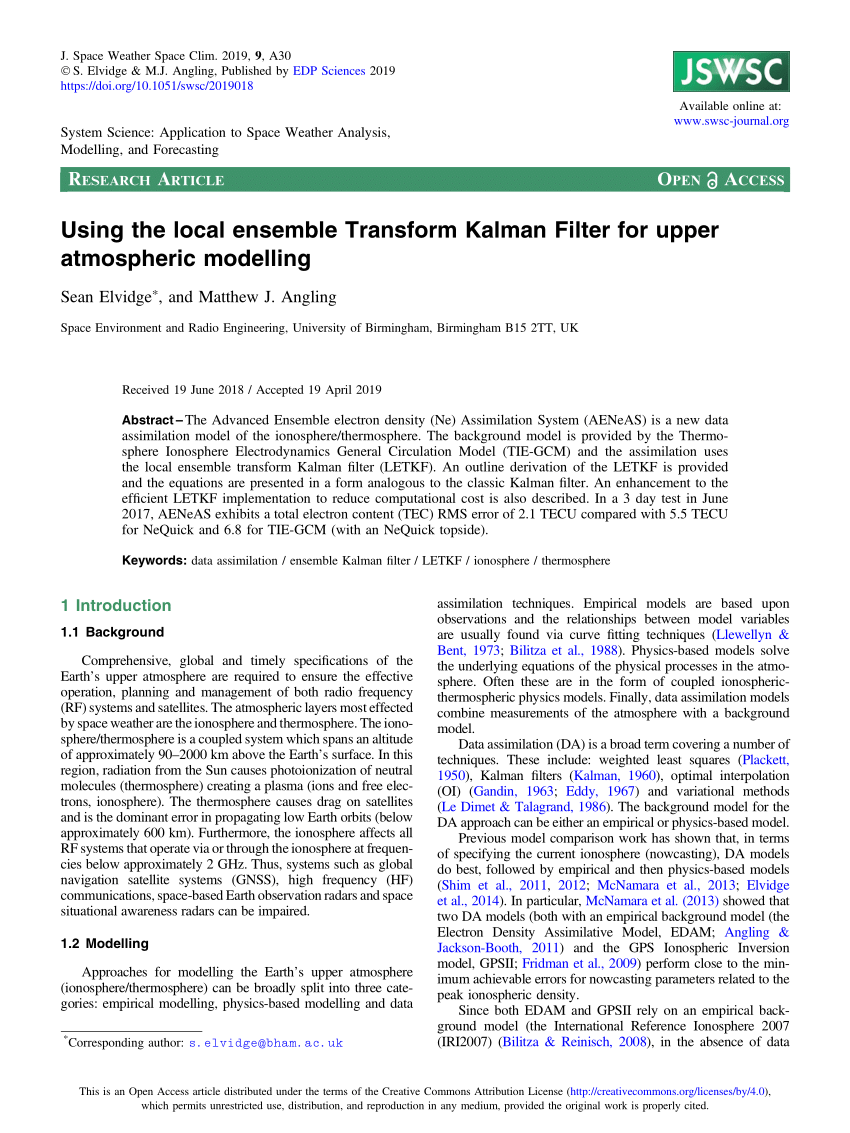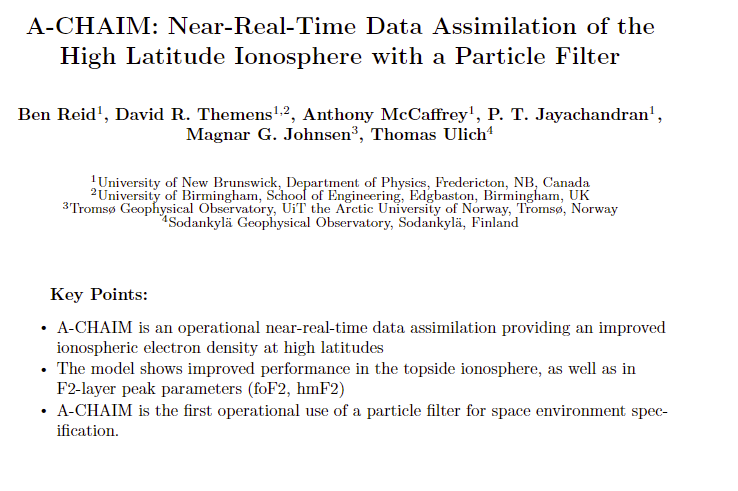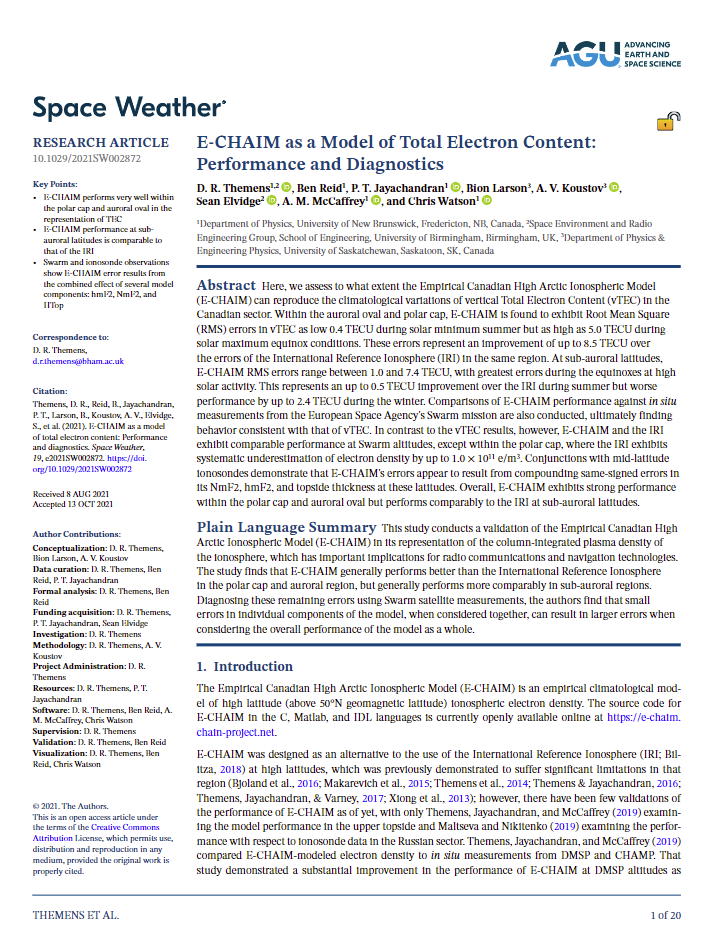Upper Atmosphere Modelling
The Sun is a dynamic and evolving object lying at the heart of our Solar System, and can release huge quantities of mass and radiation into interplanetary space in violent eruptions. When these arrive at the Earth there are significant impacts on technology, including GPS (GNSS) positioning, signal scintillation and perturbations to satellite orbits.
Mathematical models of the upper atmosphere are broadly split into three categories:
* Statistical (empirical / climatological)
* Physics-based (first principles)
* Data assimilation
SERENE’s modelling research spans all of these areas.
E-CHAIM (Empirical - Canadian High Arctic Ionospheric Model)
E-CHAIM is an empirical model designed to study high latitude electron density above 50N geomagnetic latitude. The model employs a semi-Epstein layer function, anchored at the F2 peak with height-varying thickness, to represent the full electron density profile.
Utilizing Fourier Expansion (FE) and Spherical Cap Harmonic (SCH) fits, E-CHAIM relies on a comprehensive database of ionosonde, ISR, topside sounder, and RO data. The F2 peak is characterized by three distinct models, each serving a specific purpose in understanding the ionosphere. Both the topside and bottomside are accurately represented with a focus on precise thickness and height parameters.
The model is available for you to download and play with at: http://e-chaim.chain-project.net/
A-CHAIM (Assimilation - Canadian High Arctic Ionosphere Model)
A-CHAIM is an advanced data integration system that operates in near-real-time and is built on the foundation of the empirical background model E-CHAIM. By merging information from ground and space-based GNSS receivers, Jason-2/-3 altimeters, and numerous ionosondes, the system refines the E-CHAIM background model through an adapted Auxiliary Particle Filter (APF) technique. A-CHAIM sets itself apart from other data assimilation systems by leveraging the basis functions of E-CHAIM to significantly decrease the state space size and speed up forward model calculations using analytical functions, rather than discrete voxels.
This optimization enables the use of more demanding assimilation methods, such as APFs, which offer greater flexibility and compatibility with highly non-linear datasets. A-CHAIM processes data in 5-minute intervals and employs 12th order SCHs for its horizontal basis set, while updating parameters such as NmF2, hmF2, bottomside thickness, and topside thickness. Every hour, the system initiates a new assimilation run that starts three hours before the current time and continues two hours beyond it, generating a co-rotation persistence forecast.
To ensure that each assimilation utilizes the most comprehensive data available, A-CHAIM reprocesses the same output time five times. It initially creates a state as a 2-hour forecast, followed by a 1-hour forecast, and then three more states as assimilations or reanalyses with varying data availability levels. A-CHAIM's output and tools for interpreting the output are freely accessible at https://a-chaim.chain-project.net/.
AENeAS (Advanced Ensemble electron density [Ne] Assimilation System)
SERENE has developed a novel mathematical model to enable an unprecedented level of forecasting capability, the Advanced Ensemble electron density (Ne) Assimilation System (AENeAS). AENeAS is a 4D data assimilation model which uses a first-principles physics model as its background and is combined with ground and satellite observations which are distributed all over world. This combination is controlled by an ensemble Kalman Filter (specifically the local ensemble transform Kalman filter [LETKF]).
Currently the model is being used to investigate to what extent Joule heating and radiative cooling of the thermosphere affects orbiting satellites. Addressing engineering challenges, AENeAS is used to model and forecast ionospheric and thermospheric densities to determine GNSS and HF performance for aviation applications and better predict satellite orbits, to reduce the likeliness of satellite collisions.
The model is the centre piece of two NERC-funded Space Weather Instrumentation, Measurement, Modelling and Risk (SWIMMR) grants which will result with the model being operational at the UK Met Office. Bridging a capability-gap in our ability to create accurate and actionable space weather forecasts.
AIDA (Advanced Ionospheric Data Assimilation)
AIDA is a cutting-edge ionospheric data assimilation model that employs "NeQuick" as its background model. Similar to A-CHAIM (as detailed above), it integrates data using an auxiliary particle filter. AIDA is currently running in a pre-operational mode on the ESA SWE Portal, providing output at three different frequencies:
- Ultra-Rapid (every 5 minutes)
- Rapid (every 3 hours)
- Final (daily)
Additionally, a "runs-on-request" system is under development and will be accessible on this site in the near future.
TIE-GCM (Thermosphere Ionosphere Electrondyanmics General Circulation Model)
Developed by NCAR in the United States, TIE-GCM is one of the potential background model used in AENeAS. The group help maintain this community used code, developing the "gfortran" version as well as providing model updates/fixes, regularly updated run files and a soon-to-be-released dockerized version.


